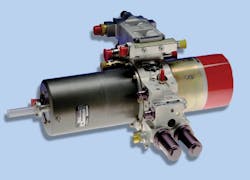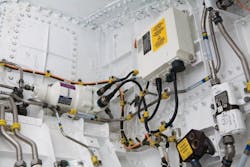Hydraulics in a More-Electric Airplane?
Is there a place for hydraulics in the more-electric airplane? Indeed there is, but the role of hydraulics is changing. In traditional aircraft hydraulic systems, two main central systems usually deliver power from the engines, through gearbox-mounted pumps, to the hydraulic actuators.
Because of their extremely high power density and reliability, hydraulic actuators are widely used for:
- primary flight controls, such as rudder, elevators, ailerons, and possibly active flight spoilers,
- secondary controls, such as flaps, slats, speed brakes, and trim,
- landing gear systems, including main and nose wheel extend-retract actuators, steering actuators, and wheel brakes, and
- utilities, such as passenger and cargo doors and thrust reverser actuators.
Centralized hydraulic systems in airplanes require a tremendous amount of tubing, considering that each system requires pressure and return lines plus case drain for the pumps; times three for a three system architecture. Furthermore, the tubing network stretches from the engine nacelles, across the firewall through the pylons into the wheel well, wings, back to the tail, and forward to the nose — plenty of opportunities for leakage.
Progressive electrics
The more-electric concept grew from the need to reduce the amount of hydraulic lines in the aircraft, not only to reduce the maintenance headaches but also reduce the complexity of installation. This is now achievable because of the increasing capability of electric generation, transmission, and actuation technology. There are basically two elements to the more electric concept — extracting power from the engine electrically rather than hydraulically, and actuating the various controls and utilities electrically rather than hydraulically.
As electric motor technology evolves, higher power density enables electric actuation to replace hydraulics for some secondary controls, such as flaps, speed brakes, trimming, and steering. This helps reduce the extent of the hydraulic network in the airplane. Primary flight controls are also migrating toward more electric, in the form of electro-hydrostatic actuators, or EHAs. These are essentially hydraulic actuators complete with their own dedicated miniature hydraulic power packs, so connection to a central hydraulic network is no longer needed.
A variation on the EHA theme is to use a more conventional set of hydraulic actuators for controls, such as the elevator and rudder located in the tail section of the aircraft, and supply them from a small, dedicated local hydraulic power pack. This scheme also reduces the extent of hydraulic piping necessary in the network.
These trends are tending to migrate the power extraction from the engines from hydraulic toward electric, reducing the size and number of engine driven pumps while increasing the capacity of electric generators.
The holy grail is the all-electric airplane, with novel generators embedded within engine spools. However, hydraulic actuators will ultimately still move the control surfaces for the most demanding applications. Only the myriad of tubing will be reduced.
This information was submitted by Peter Stricker, of Eaton Aerospace, Jackson, Miss. For more information, contact him at [email protected].




